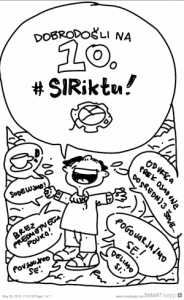Karla Koman, OŠ Toma Brejca, Kamnik
Since the curriculum contains too few lessons dedicated to ecology, I have decided to get creative with my first graders and do something sustainability-oriented that would be useful not just for school children but for others as well. Students from higher grades and people in the community in general do not have the right attitude towards nature or lack ideas for sustaining the environment. Therefore, my first graders have developed short ECO movie clips. Based on their experience and knowledge, they have put together a script and recorded the activities. They were involved actively in the “game” of waste separation and storage. Through fun activities they have developed a sense for nature and for sustaining it. In creating movie clips they have gained experience that, for a six-year-old, will be long-lasting. The movie clips had a direct impact on viewers. They became more motivated since it was the youngest students who were teaching them about the importance of keeping our planet healthy. The clips were viewed by students of all grades at the Earth Day municipal event. Furthermore, they were presented on our school web page as well as uploaded to YouTube. Thus, our first graders eco-ideas are being realized at our school. GOALS: – to maintain through independent planning and execution of activities an authentic relationship to the topic and acquire values and knowledge related to protecting the environment – to use movie clips to influence the eco-awareness of self, other students, parents and people in the community – to present the work of the eco-school on the school web page and at a municipal event – to encourage creativity and innovativeness – to develop the ability to communicate and to reach compromises – to develop the ability to use a mobile phone – to learn to work with computers CLASSROOM SCENARIO Ecology-related topics were dealt with in class, followed by conversations and brainstorming to generate ideas. Students were thinking about what they could do to care for our planet. The ideas were then illustrated within student groups. Next, a selection was made on what to film. The roles for making the videos (camera, direction, acting, screenwriting) were assigned by students themselves, whereas the teacher’s role was to supervise the activities. Finally, mobile phones were used to record the videos, which were then transferred to computers by the students and put together in Moviemaker by the teacher. DIDACTIC ADDED VALUE: Students were focused, motivated and relaxed in the learning process. They enjoyed the lessons enriched by videos. At the same time, they acquired important knowledge for life and transferred it to others. The videos will be very useful for future generations as well.
